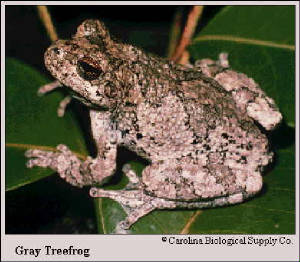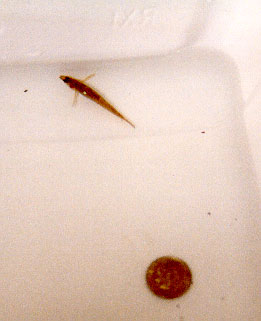|
Since your taro is growing in a pond of sorts, you can have
all sorts of water creatures if you so desire (and some whether you like it or not). This crawdad came from our turtle pond
(background – also had taro there). I see crawdads in regular taro patches, and I don’t think they hurt anything.
I don’t put them in my little ponds.

This wee frog is the “poison-dart frog”
from Manoa valley in Honolulu. I have had great success with these guys. To get them started, find a natural area with them,
and find or leave a bucket of water (ideally full of algae, their food). Eventually the frogs will colonize it. You will see
the tadpoles. Tree frogs are the only frogs that can climb up the bucket, so you won’t get toads and bullfrogs, etc.
Take the tadpoles home (where ideally you already have a bucket of algae water, fish-free) and grow them into adults. You
may have to repeat a few times, and may have to maintain a fish-free pond at first.
(A fish-free pond is a little spooky, skeeter-wise,
but I have had good luck. Skeeters mostly seem to like isolated water that does not have all of their predators in it. If
you have what I call “shrimpies” – they may be copepods – you will generally not have mosquitoes.
Start your fish-free pond with lively pond water, etc., as opposed to hose water. Toss in a little fish food or cat food or
something once a week or so.)
The poison-dart frogs do not start out in “water”
in the usual sense. They start in little pockets of water on fallen leaves and such. Then, and ~only if it gets pretty dry,
do they move the pollywogs into your ponds. The adult frogs carry the large pollywogs on their backs. So you might have
lots of frogs and never see their pollywogs. You can hear them if you listen carefully – sort of a soft cricket sound.
These frogs eat lots of ants.
Here is another attempt to show you a poison dart frog. I see them
all the time but they hop away when I get the camera close.
I also wanted to add that the polywogs can co-exist with fish,
at least to some degree and in some situations. It may be only if the polywogs get pretty mature in the leaf litter first,
and only move in with the fish once they are a little tougher. And if the fish are small and well fed. (This last summer our
"fish-free" pond had lots of both 1" fish and polywogs changing into frogs.)

There are three stages to mosquitoes before they
buzz in your ear.
The eggs – sorry, no pix – are usually
laid on the surface of water in “rafts”. These are about the size and shape of an apple seed, black, and repel
water.
In a week or so you get wrigglers, tiny at first.
These are “I” shaped, and not a problem yet. Fish love them. They feed by filtering your water – they can
make murky green water crystal clear if you give them a chance. These filter-feeders can be killed with “Mosquito Dunks”
or similar products that use a bacterium called “bt”.
In another week or two you’ll get “commas”.
Now go on red alert. You are just few days from an adult mosquito, and your options are now limited. The comma-stage larvae
don’t seem to feed, or at least don’t seem to be killed by the “Dunks”. Small fish can’t handle
them, so you have to go to at least about a 2” fish. I often just throw the water out onto the driveway if I find commas.
Kinds of fish. (Almost all fish love mosquito larvae – try any kind you have.)
Guppies – shown in picture of aquarium taro. These common “minnows”
are in streams, and often sold in pet stores as “feeder fish”. Cheap
and easy.
Red moons – They look like orange guppies to me. Main advantage is that
you can instantly see them in the water to know your fish are still alive. As long as your fish are OK, skeeters are not a
worry.
Stealth fish – (not
their real name - they are darters of some kind). These are by far my favorite if I can see the fish. For some reason they
seem full of personality and intelligence. To get them find a gravelly stream and look on the bottom. They are hard to catch
– they hide and dash between the rocks. A concrete boat landing or ford is a good place to catch them. The picture above
(with the dime) is not great but the best I have.
Dragonflies Besides tree frogs, the other reason to go fish-free is dragonflies and damselflies. These guys eat
adult mosquitoes, and their very presence seems to scare mosquitoes away.
I haven’t found a good consistent way to
raise them. Occasionally I find their larvae (little stealthy killer rocket bugs that live underwater) in swamps and ponds.
I bring them home and feed them extra fish or tadpoles. I think the little damselflies are the most likely to stay close to
home, and hunt mosquitoes in the smaller, shadier places.
The only suggestion I have now is have several ponds going on
to maximize your chances of both attracting dragonflies and to keep all of your critters alive and safe from their feeding.
Click here for some new pictures of critters http://picasaweb.google.com/raygrogan1/TaroCritters#
On to dryland taro
|